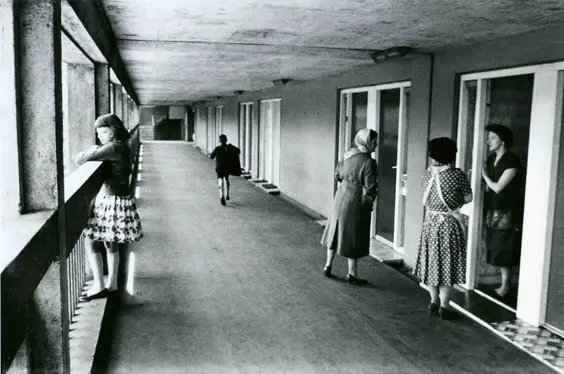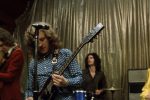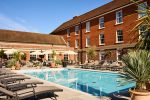A Gallery from ‘Love Among the Ruins’ Exhibition in Sheffield, Documenting Housing Projects Park Hill and Hyde Park
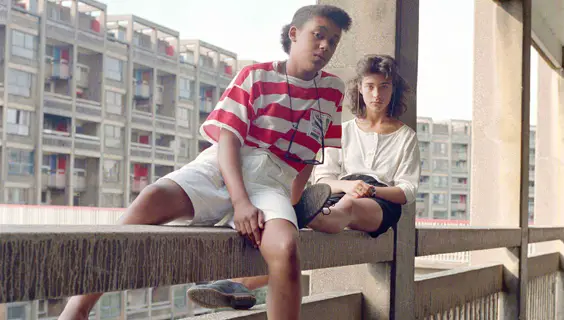
In July 2018, S1 Artspace reopens in the heart of Sheffield’s iconic Brutalist Park Hill estate with an exhibition of archival photography and film of the residents who shaped the original communities in Park Hill and neighbouring Hyde Park.
‘Love Among the Ruins: A Romance of the Near Future’ presents the work of two social documentary photographers Roger Mayne (1929 – 2014) and Bill Stephenson (b. 1955), who documented the first residents of Park Hill from 1961-65 and the last remaining residents of Park Hill’s sister building Hyde Park in 1988 – both landmark buildings which were the product of City Council Architect J. L. Womersley’s pioneering vision for social housing in Sheffield.
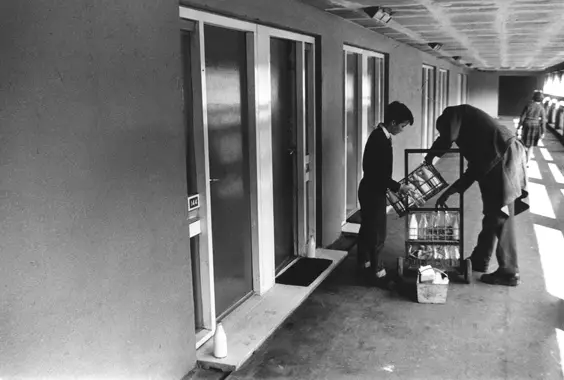
Roger Mayne, Milk delivery, Park Hill Estate, Sheffield, 1961 © Roger Mayne Archive / Mary Evans Picture Library
“A close community”
Including rare documents and archival material, ‘Love Among the Ruins’ is a re-interpretation of ‘Streets in the Sky’, an exhibition by Mayne and Stephenson curated by Matthew Conduit at the Untitled Gallery in Sheffield in 1988. Thirty years on, ‘Love Among the Ruins’ revisits aspects of the original exhibition alongside works not previously shown and includes The Fortress, a film about Park Hill produced by the BBC in 1965 as part of its Landmarks documentary TV series.
Originally staged during the most significant period of decline of the two estates, Streets in the Sky provided an insight into the sense of rootedness and connection to the architecture felt by many of the residents. Despite the increasing deterioration of the fabric of the building, Stephenson found “a close community reluctant to be broken up” and “did not meet a single resident who wanted to be rehoused, despite the current condition of the flats.”
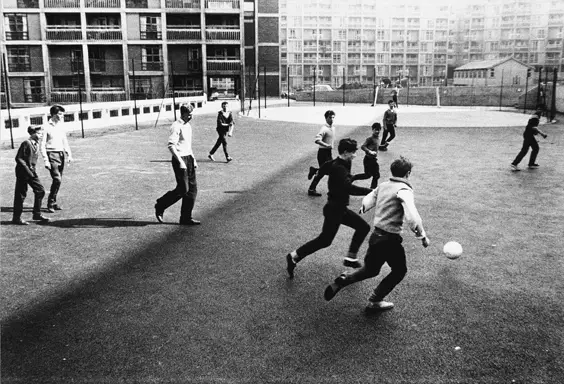
Roger Mayne, Boys playing football, Park Hill Estate, Sheffield, 1961 © Roger Mayne Archive / Mary Evans Picture Library
“Redevelopment scheme”
Looking back to the utopian ideals inherent in the architecture of Park Hill and Hyde Park, ‘Love Among the Ruins’ traces the social history of the buildings, as Park Hill is once again undergoing a huge period of reinvention following its Grade II listing in 1998 and ongoing redevelopment since 2007. Love Among the Ruins offers a moment to reflect on the major changes that the estate has experienced historically and marks the next phase in the evolution of this landmark building.
Commissioned by J. L. Womersley in 1956, the Park Hill redevelopment scheme was designed by architects Jack Lynn and Ivor Smith who were tasked with providing a solution to the post-war housing and health crisis in Sheffield. Lynn and Smith were heavily influenced by British architects Peter and Alison Smithson, who were themselves proponents of Le Corbusier’s incorporation of ‘streets in the air’ in the Unité d’habitation in Marseilles, which aimed to facilitate the sort of neighbourliness existing on the ground, with space to stand and chat and for children to play. In translating this concept to the hillside location of Park Hill, the architects were able to vertically recreate the existing streets to rehouse neighbours next to each other.
“Dramatic”
Designed to include all the amenities that people needed to live well, the Park Hill redevelopment scheme was the largest and most radical housing project of its kind outside of London. Between 1961-65, Roger Mayne visited the newly developed Park Hill estate to document how the residents were transitioning to this new way of living together. Mayne’s seminal body of work capturing community life on the streets of working class neighbourhoods of Britain in the 1950s and early 60s earned him a reputation as one of the most important post-war British photographers. His photographs of Park Hill uniquely capture the energy and conviviality of the estate at its inception.
In 1965, part two of the redevelopment scheme was completed with Hyde Park, which existed for just over 25 years before being partially demolished between 1991-93. The design for Hyde Park differed significantly from Park Hill, with the estate composed of four separate blocks and the tallest reaching a dramatic nineteen storeys high. By 1967, concerns were already being raised about the social impact of such high-density housing, with reports that applications for transfers were on the increase. From the 1970s, the estate began to suffer from chronic pest control problems and ‘generally filthy conditions’ according to a council survey. The building developed ‘concrete cancer’, as rainwater gradually caused chunks of the facade to disintegrate.
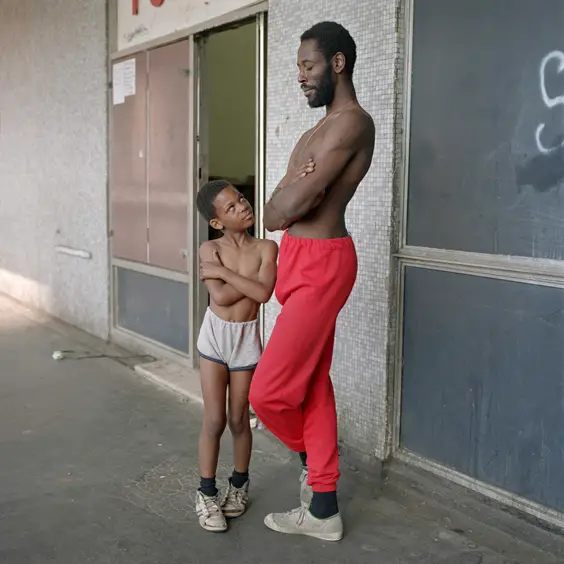
Bill Stephenson, ‘Tony the Ton’ and Martin age 8, outside the Pop In Centre. Hyde Park Flats, Sheffield, 1988
© Bill Stephenson
“Fleeting energy”
Bill Stephenson documented the last remaining residents of Hyde Park in 1988, at a time when the estate had fallen largely into disrepair and had come to be considered a failed experiment in social housing by Sheffield City Council. Having spent eight months visiting and getting to know the residents whom he would eventually photograph, Stephenson’s portraits offer a deeply personal insight into the lives of Hyde Park’s residents in contrast to the anonymity and fleeting energy of Mayne’s photographs of Park Hill.
In December 1986, 3000 tenants of Hyde Park learned that they would be rehoused in order to accommodate the ‘Olympic Village’ for the World Student Games in 1991. Tenants began moving out in January 1988, with over half having left by the end of June that year. By 1990, the city had embarked on a £27 million renovation scheme to transform the estate for the Games, with demolition of the nineteen storey Block B beginning in 1991.
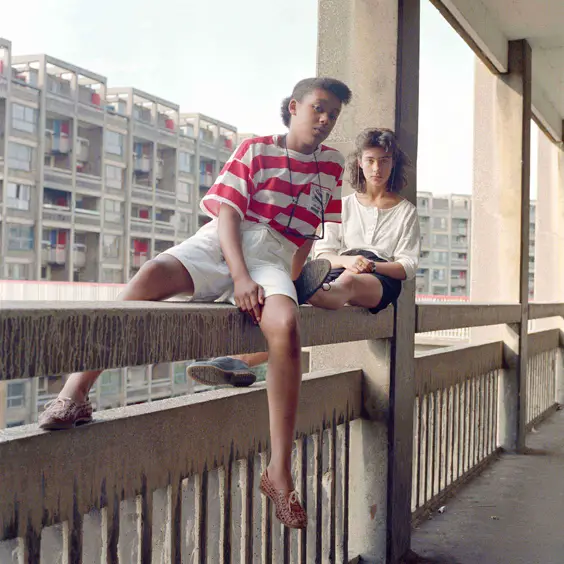
Bill Stephenson, Donna Hargreaves and Carmen Bello sit on an unguarded fourth storey concrete parapet. Hyde Park Flats, Sheffield, 1988 © Bill Stephenson
“Changing attitude”
The partial demolition of Hyde Park was part of Sheffield City Council’s city-wide programme of tower block demolition from the late 1980s to the late 90s that saw the flattening of Broomhall flats, Kelvin flats and the high-rise towers of Norfolk Park. The fate of Hyde Park became a microcosm of the changing attitude towards social housing and the welfare state in Britain, as the priorities of central government shifted away from social responsibility towards privatisation and home-ownership.
At a time when social housing is increasingly scarce and communities of post-war social housing projects have been largely fragmented and dispersed, Love Among the Ruins explores the complex social and architectural history of Park Hill and Hyde Park, providing a platform for discussion and debate about the relationships between architecture, community and the urban landscape, looking back to the post-war utopian ideals of social housing and to the contemporary repurposing and commercialisation of the remaining buildings from the period.
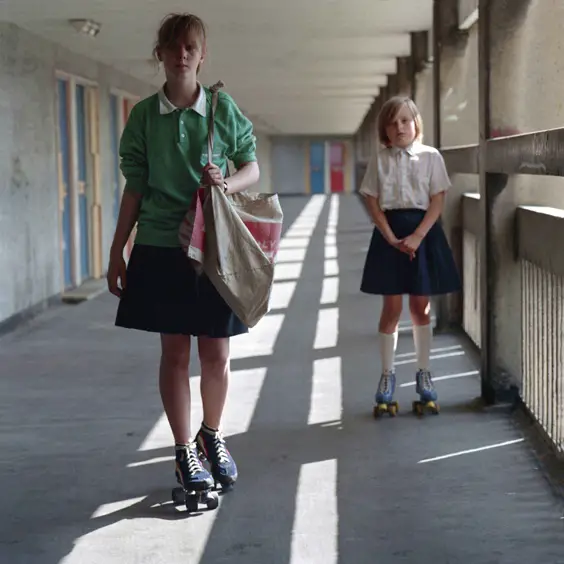
Bill Stephenson, Roller skating paper girls Anita and Emma. Hyde Park Flats, Sheffield, 1988 © Bill Stephenson
‘Love Among the Ruins’ is at S1 Artspace, 1 Norwich Street, Park Hill, Sheffield, S2 5PN
